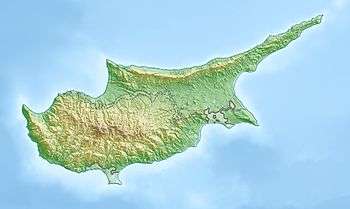Alaminos, Cyprus
Alaminos (Greek: Αλαμινός) is a village in the Larnaca District of Cyprus, west of the city of Larnaca. In 1960, prior to the Turkish invasion of Cyprus, it had 564 inhabitants, with a roughly equal number of Greek and Turkish Cypriots.[2] In 2011, its population was 345.
Alaminos | |
|---|---|
 Alaminos Location in Cyprus | |
| Coordinates: 34°48′25″N 33°25′58″E | |
| Country | Cyprus |
| District | Larnaca District |
| Government | |
| • Type | Community |
| Population (2011)[1] | |
| • Total | 345 |
| Time zone | UTC+2 (EET) |
| • Summer (DST) | UTC+3 (EEST) |
| Website | http://www.alaminos.org/ |
History and culture
Alaminos is the site of discovery of a Chalcolithic clay feminine "lactation" figurine, with hands pressing breasts.[3] Philip of Ibelin, seneschal of the Kingdom of Cyprus, had an estate at Alaminos, where he was banished in 1308.[4] The area is home to a still-extant coastal watchtower built under the Venetian rule.[5] There is also the old Church of Agios Mamas, which was restored in 2006.[6]
In the Middle Ages, Alaminos housed a monastery where the Georgian monks were active. The medieval Georgian hagiographic Life of St. John and Euthymius reports the Byzantine emperor Basil II's unsuccessful persuasion of Euthymius the Athonite to take the chair of the deceased archbishop of "Salamino".[7] A monastery operated by the Georgians at Alaminos is also mentioned by the Dominican Stephen de Lusignan, whose chronicle was published in Paris in 1580.[8] The Alexandrian Patriarch Cyprian, a Cypriot, writing in the late 18th century, reiterates that the Georgians once possessed "some Monasteries near Alamino, in the district of Mazoto, Cyprus" and adds that "no representatives of this sect are to be found, however, in the island at the present day."[9] Another important Georgian monastic foundation in Cyprus was the Gialia Monastery, some 149 km northwest of Alaminos.[8]
In December 2016, an archaeological expedition from Georgia located ruins of a church building and 14 graves, probably dating from the 12th to the 16th century.[8]
References
- "C1. POPULATION ENUMERATED BY SEX, AGE, DISTRICT, MUNICIPALITY/COMMUNITY AND QUARTER (1.10.2011)", Population - Place of Residence, 2011, Statistical Service of the Republic of Cyprus, 2014-04-17, archived from the original on 2014-04-20, retrieved 2014-04-20
- "Archived copy". Archived from the original on 2009-05-02. Retrieved 2009-06-10.CS1 maint: archived copy as title (link)
- Goring, Elizabeth (1991). "Pottery figurines: the development of coroplastic art in Chalcolithic Cyprus". Bulletin of the American Schools of Oriental Research. 282: 153–61.
- Konnari, Angel Nicolaou; Schabel, Christopher David (2005). Cyprus: Society And Culture 1191-1374. Brill. p. 81. ISBN 9004147675.
- Cosmescu, Dragoş. Venetian Renaissance Fortifications in the Mediterranean. McFarland. p. 41. ISBN 9781476620183.
- Flourentzos, Pavlos (2008). Annual Report of the Department of Antiquities for the year 2006 (PDF). Lefkosia: Republic of Cyprus Ministry of Communication and Works. p. 29. Retrieved 24 May 2017.
- Djobadze, Wachtang Z. (1976). "Materials for the Study of Georgian Monasteries in the Western Environs of Antioch-on-the- Orontes". Corpus Scriptorum Christianorum Orientalium. Louvain. 372: 77.
- "Ruins of Georgian church discovered on Cyprus". OrthoChristian.Com. 3 February 2017. Retrieved 24 May 2017.
- Dowling, Theodore Edward (1912). Sketches of Georgian Church History. London: Society for Promoting Christian Literature. p. 125.
